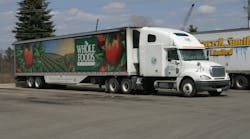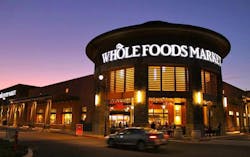How Amazon is changing supply chain thinking … and mayhap trucking too.
So now that that the initial hoopla surrounding Amazon’s purchase of high-end grocery store chain Whole Foods for $13.7 billion – a company with 431 supermarkets and 91,000 employees in the U.S., Canada and the United Kingdom that is also Amazon’s largest acquisition to date – it’s time to start thinking about this deal’s supply chain implications.
And make no mistake: those implications will impact trucking big time as well.
Let’s start with some observations by Jim Tompkins, CEO of Tompkins International and a well-known supply chain and retail operations strategy expert.
He noted in a recent white paper – entitled Food Fight: Discovering Eight Truths of the New Era of Retail – that the “foundation” for Amazon’s growth model to date has been the realization that forward deployed inventory on a massive scale produces unit delivery costs that are lower, shipping distances that are shorter, and customer satisfaction that is higher.
“The real genius behind Amazon’s model was the insight to turn its supply chain infrastructure into a collaborative platform,” Tompkins pointed out. “Greater volumes drive lower costs and lower prices, thereby attracting higher volumes.”
That’s a critical insight because “one needs to be aware that the margins in food retailing [are] substantially lower than in non-food retailing,” he stressed.
Yet the total retail and food service market is big business in the U.S., with revenues topping $5.32 trillion in 2015, which is what is makes the “food business” attractive to any company. And while online grocery sales are only a very tiny portion of that market – they topped just $20 billion in 2016, which is only expected to hit $100 billion by 2025 – George Shchegolev, co-founder and vice president of operations at software provider Route4Me, believes that Amazon is looking to use its Whole Foods acquisition in a very “non-traditional” manner, at least where grocery stores are concerned.
“Amazon rarely moves in a straightforward way. They’re strategic thinkers, chess players. They plan ahead,” he explained recently.
“Amazon has been able to convince people to pay for its Amazon Prime service by offering free two-day shipping to subscribers [and] that offer will be harder to fulfill as more and more people sign up.”
Yet as noted previously, Whole Foods has over 460 stores worldwide – and those stores now belong to Amazon, which can now use their physical spaces as distribution centers for all kinds of deliveries.“These locations offer quality in addition to quantity,” Shchegolev noted.
“Whole Foods isn’t Walmart. It’s a high-end store with high prices to match, so they’re generally located in affluent areas where residents have disposable income to throw around,” he pointed out. “That demographic – high income, urban residence – is more likely to sign up for Amazon Prime than most. By snatching up Whole Foods and hundreds of centrally-located stores, Amazon has improved its physical infrastructure significantly. Delivering orders within one to two days will be much easier for them, even as they continue to grow.”
That’s a view echoed by David Ross, managing director of the transportation & logistics research group at Stifel Capital Markets, who emphasized that in addition to opening a “new cache” of fresh, organic produce and specialty grocery to its customer base, Amazon deliveries originating from the Whole Foods' store infrastructure would provide baseload density upon which it can “layer” conventional parcels, which translates into lower last mile delivery costs.
“That same brick-and-mortar presence gives Amazon an immediate network of locations for in-store pickup, drop-off locations for consolidating returns, and new locations to install parcel lockers for 24-hour service and/or customers that don't want to wait in line,” he pointed out in a research note issued back in late June.
“Faster delivery is often cost-prohibitive, as existing national and super-regional parcel delivery networks were not set up for same day or even next day speed on a relatively low-cost basis,” Ross said.“Consumers are usually unwilling to pay up for the extra service, in our view, which means that for now, same day remains only a niche,” he stressed. “The solution that Amazon has found, in our view, is to drive inventory closer and closer to the consumer, thus reducing the length and cost of the last mile stem. Theoretically, Whole Foods' existing store infrastructure is the next evolution of that model, allowing Amazon to position not just grocery and fresh foods, but also traditional e-commerce inventory at the neighborhood level.”
So how does trucking get affected by all of this? Think about tractor-trailers and straight trucks not only resupplying Whole Foods stories with groceries but also using them as pickup and drop-off locations for all sorts of other goods being bought and returned by Amazon customers online.
And there’s potentially a lot of extra value in closer management of a “reverse logistics” chain, Ross noted.
“Even though 10% to 40% of goods bought online today are returned, depending on company and product segment, this is still an area typically neglected,” he said. “Most – over half – of items returned are in salable condition and should be put back in inventory as soon as possible to keep inventories low, while maintaining margins and avoiding stock-outs.”
And it that is all part of providing consumers with “maximum choice,” Ross stressed, whether they are buying a product or returning it.
“Of course, choice has a cost: choice means higher inventory costs, higher transport costs, and higher returns,” Ross explained. “So we wonder if this will be reflected in higher pricing at some point. We believe it should.”
And maybe – just maybe – truckers will get a piece of that “higher pricing” too, in lanes that are more short-haul in nature and thus conceivably more attractive to drivers.
We’ll see what develops.





